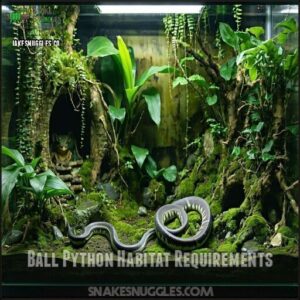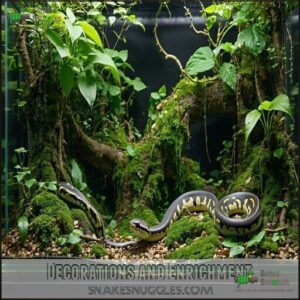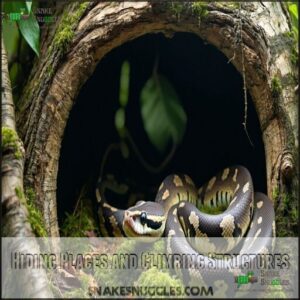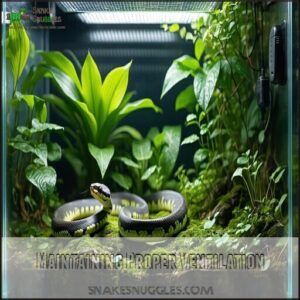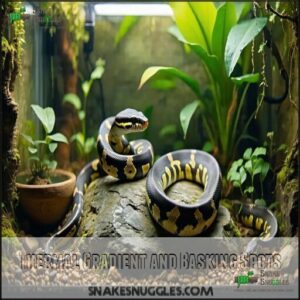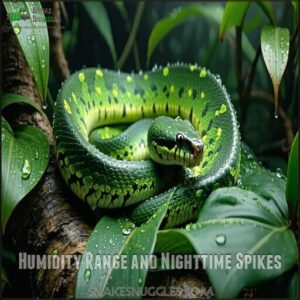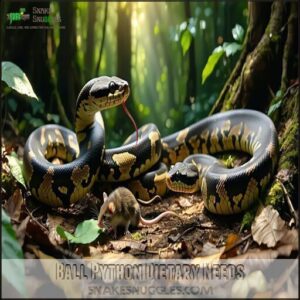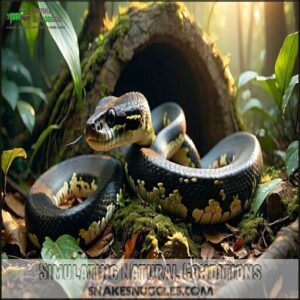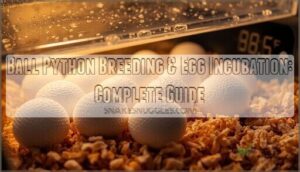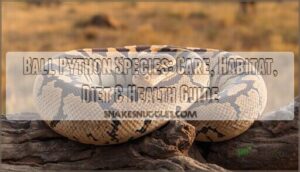This site is supported by our readers. We may earn a commission, at no cost to you, if you purchase through links.

They’re used to temperatures between 75-92°F and humidity levels of 50-60%.
In the wild, they spend their days hidden in burrows, termite mounds, or hollow logs, coming out mostly at night to hunt.
Their natural environment includes a mix of ground cover and low branches for occasional climbing.
Creating a similar habitat at home means providing both warm and cool areas, appropriate hiding spots, and maintaining consistent humidity.
Understanding these natural patterns holds the key to keeping your pet truly comfortable.
Table Of Contents
Key Takeaways
- You’ll need to maintain temperatures between 75-92°F and humidity levels of 50-60% to mimic your ball python’s West African savanna habitat, increasing humidity to 70% during shedding periods.
- Create a proper thermal gradient with a warm side (88-92°F) and cool side (75-80°F), allowing your snake to thermoregulate naturally as they would in their nocturnal lifestyle.
- Provide at least two secure hides (one on each temperature side) and incorporate low branches for climbing to replicate the burrows, termite mounds, and logs they use in the wild.
- Maintain a consistent 12-hour light cycle and ensure your ball python has its own enclosure, as they’re naturally solitary creatures that need space to express their natural behaviors.
Ball Python Habitat Requirements
To keep your ball python healthy, you’ll need to replicate the warm, humid environment of their African savanna home.
Provide the right enclosure size, substrate, temperature gradient, and humidity levels to guarantee their comfort and well-being.
Enclosure Size and Type
Your ball python needs the right home to thrive. Adult ball pythons require a minimum enclosure size of 4x2x2 feet, with larger being better for their natural behaviors.
- Glass aquariums (40+ gallons) provide excellent visibility but may need additional insulation
- PVC enclosures maintain humidity better than glass
- Front-opening terrariums reduce stress during maintenance
- Plastic tubs work well as grow-out enclosures for juveniles
Ensure proper ventilation and secure locks to prevent escapes.
Substrate Options and Depth
Choosing the right substrate for your ball python’s home can make or break their comfort.
Aim for a 2-4 inch layer of cypress mulch, coconut fiber, or aspen shavings to maintain ideal humidity. You can also create naturalistic bioactivity with mixtures like ReptiChip, EcoEarth, and sphagnum moss.
You can easily find python bedding online for convenient purchasing.
Spot clean waste regularly, replace substrate every 3-4 months, and deep clean the entire habitat twice yearly.
Temperature and Humidity Levels
Consistently maintaining proper temperature and humidity levels is essential for your ball python’s health.
Create an ideal gradient with warm side temperatures of 80-85°F and cool side at 75-80°F. Your basking temperature should reach 88-92°F, while allowing nighttime drops to 70-78°F for thermal regulation.
Keep ideal humidity between 50-60%, increasing to 70-80% during shedding cycles. Daily humidity monitoring prevents respiratory issues that can develop when levels drop below 60%.
A vital aspect of their care involves understanding their need for proper thermal gradients to facilitate thermoregulation.
Lighting and UVB Needs
While maintaining proper temperatures, you’ll also need to take into account your ball python’s lighting setup.
Though ball pythons don’t require UVB to survive, providing low-intensity UVB lighting offers significant health benefits.
A 12-hour lighting schedule mimics their natural habitat and supports immune function.
Place a linear T5 HO fluorescent tube (not coil bulbs) over the warm side of the enclosure for 8-12 hours daily, following a schedule that includes a 12-hour lighting period.
Creating Natural Environment
You’ll need to recreate the conditions of West African savannas to help your ball python thrive, including proper decorations, hiding spots, and climbing structures that mimic their natural habitat.
Maintaining adequate ventilation while preserving humidity guarantees your snake feels secure and comfortable, similar to how they’d navigate the microhabitats found in their native grasslands and forests.
Decorations and Enrichment
Five key elements transform a basic ball python enclosure into a naturalistic habitat.
Add branches for climbing opportunities and cork flats that mimic tree bark. Incorporate live or artificial plants for environmental enrichment and visual barriers.
Use moss to create humidity pockets. Varying substrate types add texture and enrichment benefits.
Rotate decorations monthly to provide ongoing stimulation methods, preventing boredom while maintaining the snake’s sense of security. This approach ensures the snake’s environment remains engaging and naturalistic.
Hiding Places and Climbing Structures
Every ball python requires at least two secure hides—one on the warm side and one on the cool side of their enclosure.
These hiding places provide essential security and mimic their natural habitat.
Add sturdy branches and climbing logs for environmental enrichment, but guarantee structural integrity as these snakes are surprisingly active explorers.
A naturalistic design with cork rounds and low perches supports their mental well-being without risking dangerous falls.
Adequate shelter is key, so consider various hide options.
Maintaining Proper Ventilation
While hiding spots give your ball python security, proper ventilation plays an equally important role in their natural environment.
Your snake’s enclosure needs adequate airflow to prevent stale air and mold growth, while still maintaining humidity levels. To further support their well-being, consider full-spectrum LED benefits for visual stimulation.
Here are 5 ventilation methods for your ball python habitat:
- Mesh top panels allow air exchange
- Side vents create cross-ventilation
- Small holes in plastic enclosures provide controlled airflow
- Front vents help establish temperature gradients
- Strategic placement away from drafts prevents stress
By following these guidelines, you can create a healthy and comfortable environment for your ball python, ensuring their well-being and security.
Temperature and Humidity Control
You’ll need to maintain specific temperature and humidity levels to recreate your ball python’s native African climate.
Creating a proper thermal gradient with temperatures ranging from 78°F on the cool side to 95°F on the warm side, along with humidity levels between 60-80%, will help your snake thrive in captivity, by providing a suitable environment that mimics its natural thermal gradient.
Thermal Gradient and Basking Spots
Ball pythons thrive with a proper temperature gradient in their enclosure.
Create this by placing heat sources at one end, allowing your snake to thermoregulate naturally.
Maintain basking temperatures of 90-92°F at the warm side while keeping the cool side around 78-80°F.
Use thermostats to control heat sources and prevent overheating.
Proper thermoregulation is essential for their well-being.
Naturalistic basking spots with varying ambient temperatures mimic their African savanna habitat perfectly.
Humidity Range and Nighttime Spikes
Beyond maintaining proper temperatures, humidity is equally important in your ball python habitat.
In their native tropical grasslands, humidity levels fluctuate naturally—60-80% during the day and climbing to 80-100% at night.
You’ll want to replicate this pattern in captivity, aiming for 50-60% normally and increasing to 70% during shedding periods.
Proper humidity monitoring prevents respiratory infections while supporting healthy hydration methods through regular enclosure misting.
Measuring and Regulating Temperature
Maintaining proper temperature regulation in your ball python habitat requires reliable equipment and consistent monitoring.
You’ll need accurate tools to replicate their natural West African environment.
- Place digital thermometers on both warm and cool sides of the enclosure
- Install temperature probes at ground level where your snake spends most time
- Use thermostats to control all heating methods (heat mats, ceramic heaters, radiant panels)
- Create a basking gradient from 90-92°F down to 78-80°F
- Allow a natural nighttime drop of 3-5 degrees to mimic habitat conditions and ensure a healthy environment with proper temperature regulation.
Ball Python Dietary Needs
You’ll need to feed your ball python appropriately sized rodents that mirror their natural diet in the wild, typically rats that match the width of their mid-body.
Your snake’s feeding schedule will vary with age, with juveniles requiring weekly meals and adults eating every 1-2 weeks, ensuring proper nutrition while maintaining their natural hunting patterns.
Prey Items and Feeding Frequency
With temperature and humidity dialed in, your ball python’s diet comes next.
Feed your snake appropriately-sized rodents that match the thickest part of their body.
Choose frozen, prekilled prey over live for safety.
Hatchlings need feeding every 5 days, juveniles every 7-14 days, and adults every 2-6 weeks.
Vary their mammalian prey with mice, rats, and occasionally quail to mimic natural dietary variety.
Supplementing With Calcium and Vitamins
Unlike many reptiles, ball pythons rarely need vitamin or calcium supplements when fed whole prey items.
Their natural diet provides complete nutrition, as rodents contain bones, organs, and muscles with necessary nutrients.
If you’re concerned about deficiencies, occasional light dusting (once monthly) with a 50/50 calcium and multivitamin mix on prey is sufficient.
Avoid overdosing, as excessive supplementation can cause more harm than good, and remember that their natural diet already provides complete nutrition.
Fresh Water and Hydration
While ball pythons don’t need supplements with a proper rodent diet, fresh water remains essential for their health.
Always provide a sturdy water bowl large enough for your snake to soak in, especially during shedding. Clean and refill the bowl daily to prevent bacterial growth.
Look for dehydration signs like wrinkled skin or stuck shed. Proper hydration works alongside humidity levels to maintain ideal snake habitat conditions.
If dehydration occurs, soaking them helps.
Simulating Natural Conditions
You’ll need to recreate key elements from West African savannas to help your ball python thrive in captivity.
Maintaining proper day-night cycles, providing secure hiding spots, and ensuring appropriate solitary housing will substantially reduce stress and promote natural behaviors in your pet snake.
Replicating Day and Night Cycles
Proper feeding supports your ball python’s health, but don’t overlook their day-night cycle needs.
Set up a consistent 12-hour photoperiod length with automatic timers to mimic natural conditions.
During daylight hours, provide UVB lighting with appropriate basking temperatures (94-96°F).
For nighttime, temperatures can drop slightly while avoiding white lights.
Consider gradual shifts at dawn and dusk, and adjust for seasonal changes to maintain your snake’s natural rhythms.
Managing Stress and Security
Just as lighting cycles help regulate your ball python’s behavior, creating a stress-free environment is equally important.
Cover three sides of the enclosure to provide security, mimicking their natural hiding spots.
Limit handling to 15-20 minutes, recognizing stress signs like hissing or ball formation.
When transporting your snake, use secure containers with proper ventilation. Remember, a calm snake is a healthy snake—their behavior will tell you if your habitat setup meets their security needs.
Providing Solitary Housing and Space
Wild ball pythons are solitary by nature. Your snake needs its own space—never house multiple pythons together as this causes stress and potential aggression.
Provide ample room with proper enclosure dimensions (minimum 4’x2’x2′ for adults). Within this reptile enclosure, create multiple zones for different activity levels.
Space enrichment through varied hiding spots and climbing opportunities allows your python to exercise natural behaviors while enjoying the solitary benefits of a well-designed habitat. Many keepers find that PVC enclosures offer superior moisture resistance.
Frequently Asked Questions (FAQs)
What are ball pythons like in the wild?
In their native West African habitats, you’ll find these docile snakes living solitary lives in savannas and grasslands.
They’re nocturnal creatures that spend daylight hours hiding in abandoned termite mounds or rodent burrows, which is a key aspect of their solitary lives.
How do ball pythons behave during rainfall?
A million times more active during rainfall, you’ll notice ball pythons climb trees to escape muddy ground and emerge from burrows.
They’ll seek food opportunities as insects and prey become active, while occasionally sheltering in termite mounds during heavy downpours, and this behavior is particularly notable as they become more active.
When do ball pythons naturally breed in Africa?
You’ll find ball pythons breeding during two main seasons in Africa: February to April during the rainy season, and September through November during the minor rainy season.
They’ll lay eggs in the dry season afterward, which is a complete concept in their breeding cycle.
What predators hunt ball pythons in nature?
Like David facing Goliath, your ball python has natural enemies too.
In Africa, they’re hunted by monitor lizards, birds of prey, wild cats, hyenas, and larger snakes seeking an opportunistic meal.
Do ball pythons share burrows with other animals?
Yes, you’ll often find ball pythons sharing burrows with other snakes and animals. They’ve been documented occupying termite mounds and rodent burrows, sometimes congregating together in resource-rich areas by choice.
How far do ball pythons travel daily?
Ball pythons typically travel 100-200 meters daily in the wild.
During daylight hours, they’ll move about 32 meters, and at night, they’ll travel around 18 meters.
They’re relatively sedentary creatures compared to other python species.
Conclusion
Coincidentally, understanding ball python natural habitat conditions is the most effective way to guarantee your pet thrives.
By recreating their West African environment with proper temperature gradients (75-92°F), consistent humidity (50-60%), and strategic hiding spots, you’re providing essential comfort for these nocturnal reptiles.
Remember, your snake doesn’t need elaborate setups—it needs authenticity.
When you respect their natural preferences for security, proper heat, and appropriate humidity, you’ll enjoy a healthier, more content companion for years to come.
- https://www.dontletitloose.com/rehoming-a-pet/
- http://genomics.senescence.info/species/entry.php?species=Python_regius
- http://www.demogr.mpg.de//cgi-bin/longevityrecords/reference.plx?data=2769
- https://image.petmd.com/files/2024-12/1730300-24-10-PMD-BallPythonCareSheetPrint.pdf?VersionId=Fv06m3ReK50k_ySRUP.LbxXxGfkoQWD8?utm_source=petmd.com&utm_campaign=caresheet&utm_medium=PDF
- https://amccorona.com/wp-content/uploads/2020/05/ARAV_trifold_ball_pythonv2_2.pdf

